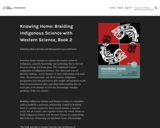
Short Description:
Knowing Home attempts to capture the creative vision of Indigenous scientific knowledge and technology that is derived from an ecology of a home place. The traditional wisdom component of Indigenous Science—the values and ways of decision-making—assists humans in their relationship with each other, the land and water, and all of creation. Indigenous perspectives have the potential to give insight and guidance to the kind of environmental ethics and deep understanding that we must gain as we attempt to solve the increasingly complex problems of the 21st century.NewParaBraiding Indigenous Science and Western Science is a metaphor used to establish a particular relationship. Linked by braiding, there is a certain reciprocity. Each strand remains a separate entity, but all strands come together to form the whole. When we braid Indigenous Science with Western Science we acknowledge that both ways of knowing are legitimate forms of knowledge.NewParaThe book provides a window into the vast storehouse of innovations and technologies of the Indigenous peoples who live in Northwestern North America. It is our hope that the Indigenous Science examples, research and curriculum models will inspire deep reflection regarding the under-representation of Aboriginal students in the sciences. It is intended that the rich examples and cases, combined with the resources listed in the appendices, will enable teachers and students to explore Indigenous Science examples in the classroom, and in addition, support the development of curriculum projects in home places.
Word Count: 88142
(Note: This resource's metadata has been created automatically by reformatting and/or combining the information that the author initially provided as part of a bulk import process.)
- Subject:
- Education
- Material Type:
- Textbook
- Provider:
- University of Victoria
- Provider Set:
- University of Victoria Libraries
- Author:
- Edited by Gloria Snively
- Wanosts'a7 Lorna Williams
- Date Added:
- 11/30/2018